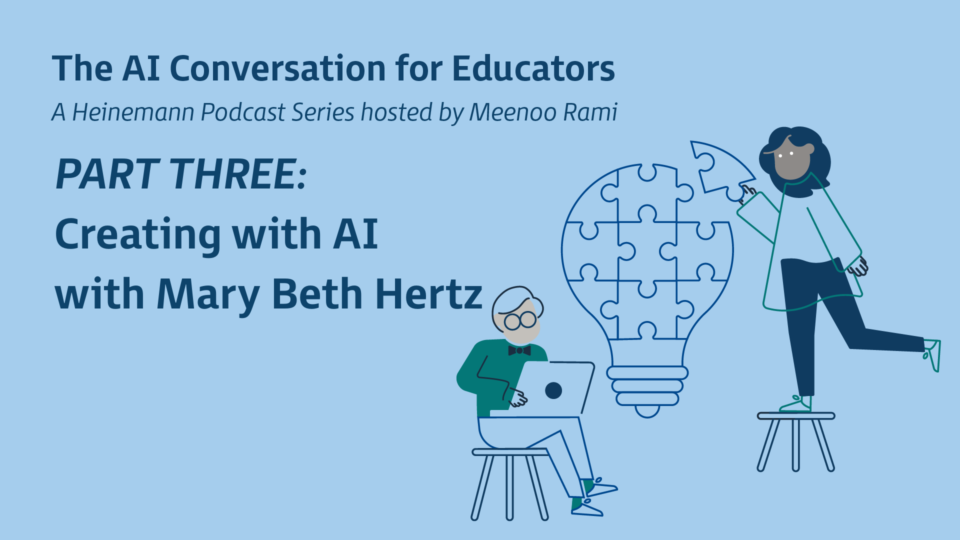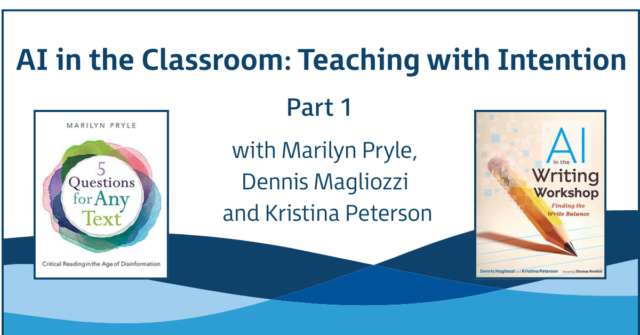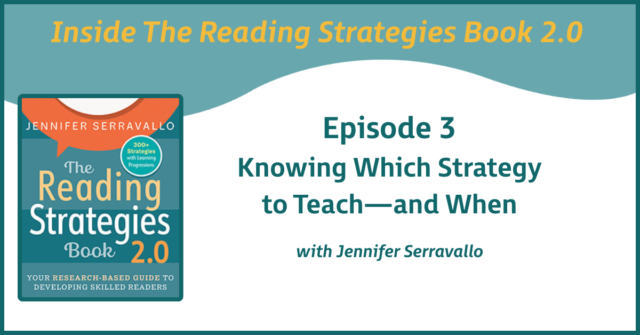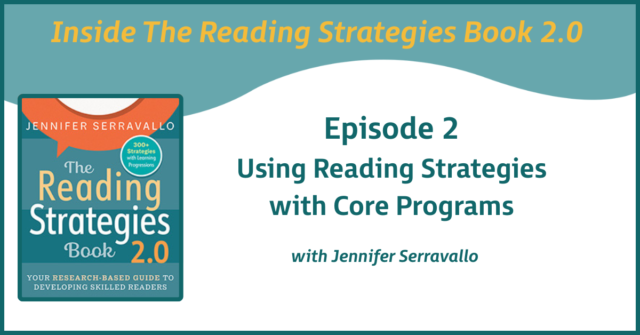
Welcome to The AI Conversation for Educators, A Heinemann Podcast Series hosted by Meenoo Rami.
This series for teachers explores how generative AI is transforming teaching and learning.
In this episode, Meenoo Rami speaks with Mary Beth Hertz, art and technology teacher at SLA Beeber High School in Philadelphia, author of Digital and Media Literacy: Practical Classroom Applications, and the executive director of Walkabout Education.
Together they discuss:
- Why she makes space for honest conversation about bias, privacy, and ethical use
- How educators can introduce AI in ways that support creativity, critical thinking, and student voice.
- How her students use tools like Adobe Firefly in her art class
- How she scaffolds digital literacy through inquiry
Transcript
Mary Beth Hertz:
It's been an interesting journey over the last couple years, as the AI explosion I guess has happened. When the first gen AI tool, obviously ChatGPT, and also Claude, and some of these tools came online and started being accessed freely, one of my first things that I jumped into was the privacy piece and the student data piece. Partially because being an old lady and having done this for a long time, I remember as you do, was it Web 2.0, we're like, "Oh my God, we can interact with the web." We were signing kids up for accounts and doing all this stuff. We didn't even think about what these companies were doing with their data.
I think I'm in this weird place, you know when you're standing with feet over the crevice and you're trying not to fall through the crack because you just can't figure out ... I can't pick a side, I guess, is where I've been. Where I understand the importance of young people understanding these tools and understanding what they can do. I also understand the potential gap that can widen when you have a subset of students that are learning these things, and understanding these things, and leveraging these things, and those that aren't, and the potential there to widen gaps that we've been really working hard to close or narrow. But I also, I'm not jumping on the hurrah, hurrah, AI in the classroom bandwagon. I also have lots of concerns.
Even in my own classroom, I was grading stuff today where I was like ... Literally, kids are being asked very simple things that would maybe be a two sentence answer and they're using AI rather than using their own brain to answer the question. Part of that is complex and I'm probably going all over the place here because that's my brain. I had a conversation with my colleague about this. The tasks that I was grading, for better or for worse, I own was a task that was a graduation requirement task that was very, "I don't give a crap about this."
Meenoo Rami:
Right, yeah.
Mary Beth:
I don't give a crap about it, you don't give a crap about it, and AI came to save us.
Meenoo:
Yeah.
Mary Beth:
But at the same time, I feel strongly that I need to point out to the students, A, the prompt was this, this didn't actually answer the prompt. While you used AI, you didn't answer the question. Also, you overdid it. Because as you and I know AI, that it's an overachiever. It always gives you more.
It's this really tricky balance. And at the same time, just to give on the flip side, in my art class, we're doing linoleum cuts. As an English teacher, you probably love this.
Meenoo:
Yeah.
Mary Beth:
They have two pieces of writing that they have to illustrate. They wrote the writing all by themselves.
Meenoo:
Wow.
Mary Beth:
Then now, they have to come up with an illustration and doing a lino cut of it. I have a broad variety of skillsets, of art skillsets in my classroom. And motor skills even. When kids have text and they want to illustrate, I said, "Open up Adobe Firefly, put in your stuff, and let's see what it makes." For a couple kids, it was like, "Ah! That's the thing that was in my brain." At the same time, I understand that power to get a kid unstuck. When a purpose of the assignment is to illustrate text, it's just a tool that's going to help them do that. In the end, they're making the art. It's a really complex way to walk.
As far as where I see EdTech going in this direction, I think sadly, it's the same way it's always been. It's people looking for where's the money?
Meenoo:
Right.
Mary Beth:
If I can build this tool that I can put into classrooms, the pedagogy ...
Meenoo:
Right.
Mary Beth:
Yeah. It's a really complex, tricky place to be. I feel like I'm not standing in any particular space I guess. Leaning maybe more towards the curmudgeonly let's think about this carefully side.
Meenoo:
Yeah.
Mary Beth:
But I still use it in my classroom.
Meenoo:
Yeah. I think why I wanted to talk to you on an episode like this one is some of your grappling and some of your own meta thinking about your own responsibility and role in what your students do with AI and how they make sense of it. There is the equity and access piece, but there is the potential over-reliance piece. But then, there is that really important concern about being guardian for your students and considering implications of safety, and privacy, and safe data usage. I think hopefully a lot of people who are listening to this feel like there in a similar place and they get to hear from a voice like yours.
You talk a little bit about the way your students are using AI as a way to brainstorm or get started on a task that they might struggle with. Is there a place in your classroom or in your practice, an example, where AI has helped your students learn better or has made their learning better?
Mary Beth:
Yeah. I think it's hard in my content areas. I'm not an English teacher, a math teacher. I'm not a traditional content area teacher. I use Adobe Firefly a lot in the art room. I tell them that I use Adobe Firefly because it uses its stock photos. I talk to them about, "No, you can't make a fake picture of Beyonce using Adobe Firefly." I explain to them why we use that tool.
I will say my freshman class, I teach an intro to tech class that all freshman take when they come to our school, we do a digital literacy unit. Part of that digital literacy unit is AI. We learn about how it works. We learn about what it is. We learn about how it's just basically spitting out the internet. They write questions, we talk to Claude. I tell them the reason why we use Claude, it doesn't use your conversations to train.
Meenoo:
Yeah.
Mary Beth:
Your conversations won't end up in other people's conversations-
Meenoo:
Right.
Mary Beth:
... with the tool. After the modeling and showing them, because they write their questions on sticky notes. Then I collect the sticky notes, then I just randomly pick a sticky note and go, "Okay, this is a question," I type it in. Then I turn them around to have them use Gemini and they had to turn in of what they were talking about. But I was just blown away by some of the conversations that they were having that were existential conversations. Or they were asking, "Can you explain this to me?" Intentionally, when I modeled, I explained to them how if you don't understand the Pythagorean theorem, have it explain the Pythagorean theorem.
Meenoo:
Right.
Mary Beth:
If you are in a class and you don't understand something, it can explain something. But also, I've shown them many examples of the hallucinations so that they understand that, okay, you got your answer, what's the next step? One of the kids was like, "Copy-paste." I was like, "What's the next step?" Then one of the kids was like, "You have to check the information!"
Meenoo:
Right. I think one of the things that I hope people note is the importance of having the opportunity to practice with a caring adult in the room. Modeling how you prompt, modeling how you evaluate the response that you get back. Understanding that they're not talking to a magical being. It's a tool and it has its biases and limitations. I think that's really important to note.
To go back to your art students for a second, since you do use things like Adobe Firefly. Have you seen your students do something creative or interesting with AI in your classroom?
Mary Beth:
I had a student who, this was for a different project, they had to create their own art movement. They had to identify an issue or a theme that they wanted to explore, and then they had to create two artworks that were connected to that theme. So that they were a series, a movement has to have some kind of connecting piece to it. One of my students was really struggling because his theme was imagination. You can imagine trying to create artwork around that theme. He had this whole idea of he wanted wings and he just kept really struggling with the wings. Adobe Firefly, he was able to put stuff in and the wings he was trying to create were there. What's really neat was really it was just the wings that he used.
Meenoo:
Right.
Mary Beth:
He just was able to take ... They were angel-type wings. He was just able to take that and nothing else but wings in the picture, and he was able to take that and use it in his work. What's neat was he was using Procreate. I just was able to Airdrop the picture. Yeah, because we did it on my computer. I Airdropped the picture to the iPad and he was able to pull it in as a layer and add it to the piece.
The reason why that sticks out to me is that he really was just looking for that one piece, not a whole picture. That helped him finish his artwork that he had already started.
Meenoo:
It's another example of AI serving as a tool, a sidekick, or a support, rather than the whole solution or whole answer to the work that the student's working on.
How do you see students feeling about using AI? Does anything surprise you there? Do they have any feelings about it? Are some reluctant, are some just jumping in?
Mary Beth:
I think it really depends on the assignment, the task, and the context. If I think I'm being given busywork that's not worth my time-
Meenoo:
Yeah.
Mary Beth:
... I'm going to cut some corners. If I am a procrastinator and it's the night before and I haven't done anything, I'm going to cut some corners.
My ninth-graders did Ignite presentations.
Meenoo:
Oh, yeah, yeah.
Mary Beth:
They had to pick a topic that we'd been studying in the digital literacy unit and some of those chose AI. They talked about how it can help, but also it's bias because we learned about all the biases that are built into the libraries, I guess, of data. I think that students are thoughtful, I think they do care. I think that they're going to make decisions based on the moment.
I think one thing that happened during COVID is school became very transactional. I give you this, you give me this. I give you this, you give me this. One thing that we've been up against over the last couple of years is breaking that transactional understanding of learning. When you have a transactional understanding of learning, AI is great to be like, "You asked me the thing, I gave you the thing. We're done here now." I think that also is, it depends on the student, but I think there are some students who are still stuck in that, "I don't understand. I gave you the thing you asked for."
Meenoo:
Right. It reminds me of the Paul O'Farrell idea of the banking system, that transactional model makes me think of that. What we've been doing through these conversations is a quick rapid round of questions, so we'll just go into that. What's the most fun you've had with AI, whether at work or in your personal life?
Mary Beth:
Playing around with image generators and seeing that when I put this in, what is it going to create. Sometimes, especially in the very beginning with Dall-E, with the six fingers and the seared faces, and all that kind of stuff. Maybe the fun part is also watching things go from that Dall-E with the smeared faces and the six fingers, to today where you can just make these really high detailed images, which is a blessing and a curse. But I think that's been the fun part, is just seeing what it can do.
Meenoo:
When educators are looking to learn about AI, what one voice or resource would you recommend to them?
Mary Beth:
I just got a copy of The Learner's Apprentice, which was put out by CMK Press. It's by Ken Kahn. It is hands-on uses, like coding a website. Just actual things you can do and create with AI. It's the kind of thing where you can pick it up and it gives you things that you can do. As far as a way to get started or a resource that's not one of these "50 prompts you can use today."
Meenoo:
Right.
Mary Beth:
Something that's more engaging maybe. And also, pedagogically, more focused on learning.
Meenoo:
Yeah, I'll have to check it out. Thanks for recommending it. What's one thing that you wish every educator would try with AI?
Mary Beth:
If you're a humanities teacher, put one of your essay prompts or one of your assignments, your prompts into AI and see what it pulls it. As a math teacher, take one of your problem sets, put it in there, and see what comes out. Then for fun, make a fun image or be goofy.
Meenoo:
Yeah.
Mary Beth:
Or have it make a recipe. That's what my kids were really, really excited about.
Meenoo:
Yeah. I think it's a good way to have educators evaluate their own lesson design or their assignment design.
Thanks for tuning in today. This is just one episode in a four-part series on AI in education. You can hear the other episodes and read a full transcript at blog.heinemann.com.
About the Contributors

Meenoo Rami, author of Thrive, is a National Board Certified teacher who taught her students English at the Science Leadership Academy and other public schools in Philadelphia for ten years. Meenoo is a teacher-consultant for the National Writing Project. She has also worked as a teaching fellow with the Gates Foundation, where she led the portfolio to help teachers refine their practice through collaboration, and she has been a Principal Product Manager at Microsoft.

Mary Beth Hertz has been at the forefront of technology integration in the classroom through local, national, and global connections with other educators and leaders in the educational technology field. Her book, Digital and Media Literacy: Practical Classroom Applications, captures much of her work in the classroom. In addition to her two decades of K-12 classroom experience, she has run workshops and presentations centered on effectively leveraging technology for student learning and designing experiential learning opportunities to engage young people. She was named a 2010 ISTE Emerging Leader, a 2013 ASCD Emerging Leader, a 2013 PAECT Teacher of the Year, a 2023 Philly REALList Connector, and is a co-founder of EdCamp Philly and the Edcamp Foundation. She is also the Executive Director of Walkabout Education, an organization championing experiential, purpose-driven, and student-centered learning experiences for young people through the Walkabout Learning Model. She currently teaches students Visual Art, Digital and Media Literacy, and serves as the Partnership Coordinator at Science Leadership Academy at Beeber in Philadelphia.


